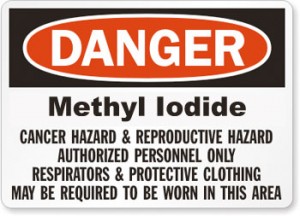Toxic Chemical Approved for Use on California Strawberries Despite Health Risks

The chemical methyl iodide has been approved for use on strawberries grown in California despite the fact that The California Office of Environmental Health Hazard Assessment listed the type of toxicity for methyl iodide as “cancer” in a document published in 2008 named “Chemicals Known to the State to Cause Cancer or Reproductive Toxicity”. The approval for strawberry growers to use this toxin has baffled scientist who know that use of the chemical poses serious risks and also spurred communities and advocacy groups to clamor against the use of the chemical on a local level, taking the protection of their health and environment into their own hands. It is unsettling when our own government allows such harmful practices and citizens have to fight so hard to keep poison out of our food.
Today, California approved a cancer-causing pesticide that scientists call “difficult, if not impossible to control,” and “one of the most toxic chemicals on earth.”
Why? Here’s my bet: the intense lobbying effort waged by Arysta LifeScience, largest private pesticide company in the world, who hired a Kentucky-based PR firm to create a “CA grassroots campaign” in favor of the pesticide, and who engaged the likes of a former assistant to Karl Rove in their efforts. Bluntly put: chemical company interests trumped the science and the concerns of Californians. Now we’ve all got an incredibly potent, new carcinogen to deal with while Arysta heads home to its headquarters and makes money off its sales.
Beyond the chemical company sway over our democracy, this irks even more because viable alternatives exist and farmers are ingeniously employing them across the state. Organic strawberries are grown small- to large-scale in California. Further, methyl iodide is linked to late-term miscarriages. Workers, who will be exposed because because fumigants are “difficult, if not impossible to control,” are deeply concerned. And finally, methyl iodide promises to contaminate our groundwater. Higher levels of iodide are already found in Florida groundwater, where methyl iodide is already being used.
~ Pesticide Action Network
(Health Change)
California’s Department of Pesticide Regulation approved the controversial pesticide methyl iodide yesterday, but chances are it’s not the end of the story.
On Monday, a coalition of environmentalists, researchers and organic farmers gathered at seven spots throughout the state to protest the impending use. That was plan A. Moving on to Plan B, Californians for Pesticide Reform, Pesticide Action Network and others advocacy groups are calling on both Governor Schwarzenegger and Governor-elect Jerry Brown to reverse the decision on the pesticide, which was influenced by intense corporate lobbying.
A fumigant used to control bacteria, pests and weeds from growing in the soil, methyl iodide was introduced as a substitute for methyl bromide, which causes damage to the ozone layer. Methyl iodide doesn’t harm ozone but is considered to be much more toxic to health.
According to the National Library of Medicine, methyl iodide is toxic to the liver, and workers have developed central nervous system poisonings after exposure. Its considered an acute pulmonary irritant that can cause chronic neurological symptoms after a heavy dermal exposure.
It has also been shown to cause cancer and miscarriages in laboratory animals.
Health concerns have made the chemical controversial since it’s original introduction. It was first approved by the Bush Administration in 2007, despite objections from over 50 scientists, including members of the National Academy of Science and Nobel laureates, who contended that the decision was made using improperly conducted scientific research.
California has its own review process, so when the chemical was being considered for use in the state it set up an independent review panel in addition to a review by staff scientists. They suggested an exposure limit of 0.8 parts per billion (ppb), but in April, when the state issued a notice to approve the chemical, the exposure limit had jumped to 96 ppb, over 120 times higher than what was considered safe.
The level set in CA is far below the EPA’s 193 ppb, but CA is also likely to see more of the chemical than the dozen or so states that currently use it.
Applied mainly on strawberries, the green light for the pesticide in California has implications for the whole country. Over 90 percent of strawberries consumed in the nation originate in the Golden State.
Farmworkers, whose exposure to the chemical will be highest, are likely to see the most health effects. Others worry that the chemical can leach into groundwater and remain on fruit.
The decision to approve the chemical baffled scientists, who believe that the chemical poses serious risks. But towns may take action into their own hands. Earlier this week, the Watsonville City Council passed a resolution noting their opposition to the pesticide’s approval. And because of the strident opposition from health experts, advocacy groups and community groups, the pressure to prevent this chemical from being used throughout the state should continue.
By: Brie Cadman
Sources:
http://health.change.org/blog/view/chemical_okd_for_use_on_ca_strawberries_despite_health_risks
http://www.panna.org/resources/specific-pesticides/methyl-iodide
http://www.pesticidereform.org/article.php?id=359
Health Freedom Alliance
Health & Wellness Foundation
CHAD Foundation
http://www.healthfreedomalliance.org